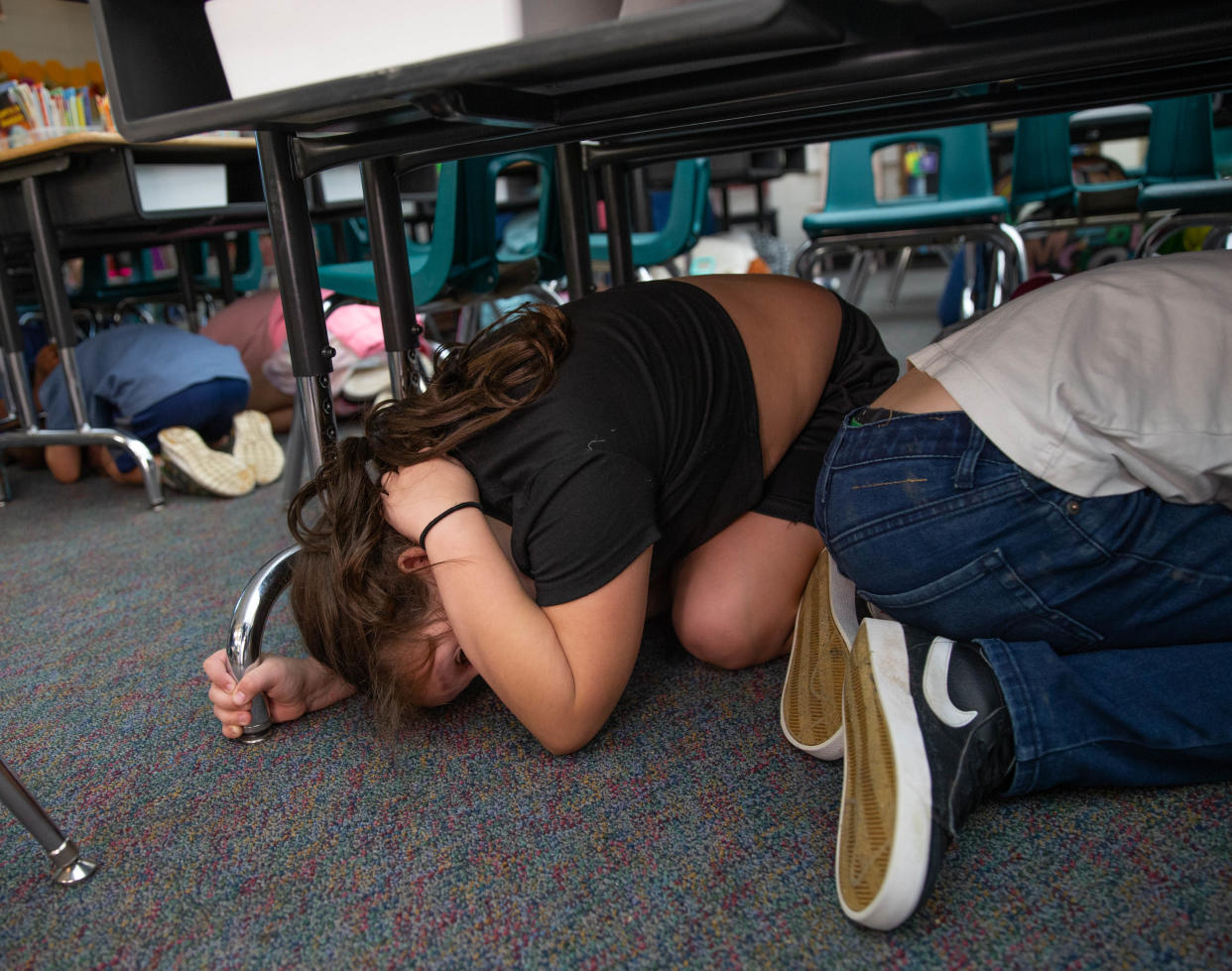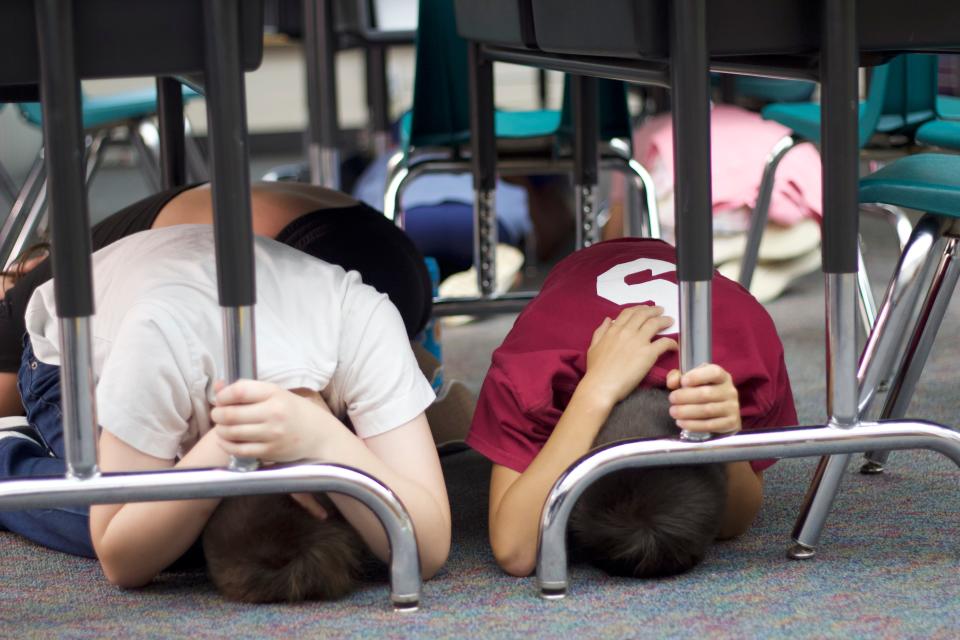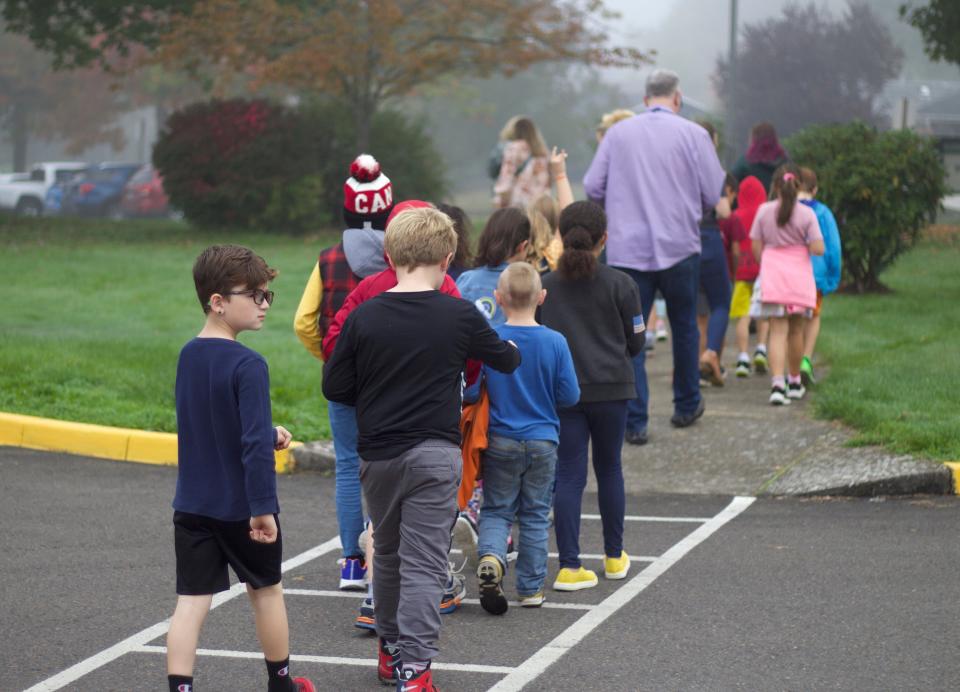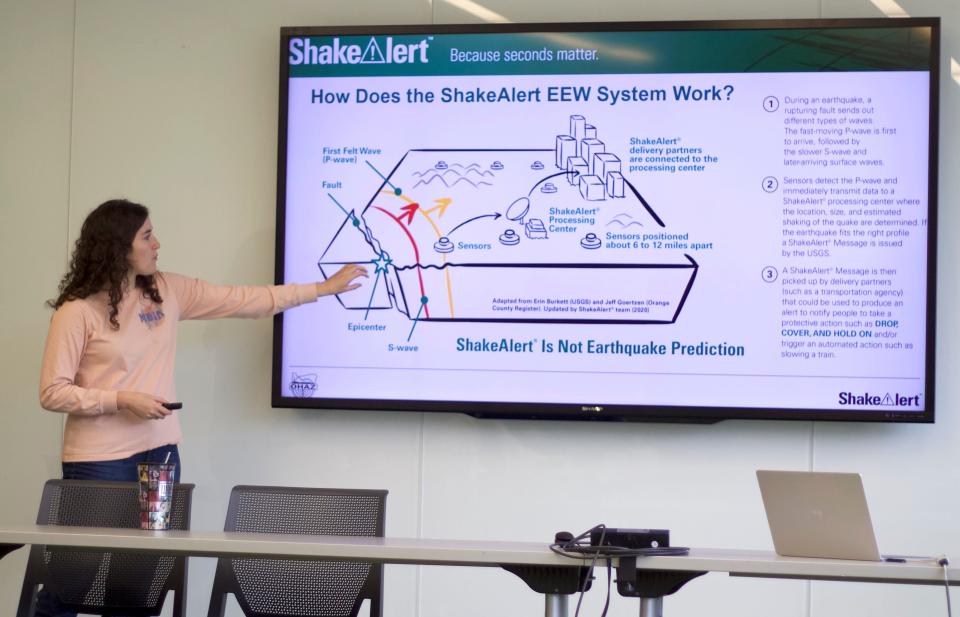Eugene schools, University of Oregon practice earthquake safety during ShakeOut

Several Lane County schools and institutions participated in the annual Great Oregon ShakeOut, when millions of people worldwide practice earthquake safety.
Organized by the Oregon Department of Emergency Management, the drill promotes earthquake preparedness. Every year at 10:19 a.m. on Oct. 19, a one minute drill commences, where participants "drop, cover and hold on" for at least one minute.
Different entities across the state participate, such as government agencies, schools, businesses, clubs and even families.
All Oregonians can receive earthquake early warning alerts on cellphones via three different methods:
Wireless emergency alerts, which are sent out automatically to all smartphones unless a user has specifically opted out in their settings.
Android OS alerts, which are sent out automatically to all Androids.
ShakeAlert-powered apps, such as MyShake, which is free to download and personalize by location in Oregon.
Eugene 4J ShakeOut
In Eugene, students in Kate Wagoner's third grade class at McCornack Elementary School went over the steps for earthquake safety before Thursday's ShakeOut, knowing the drill was coming and to:
Stop what you're doing.
Drop to the ground.
Cover your head and neck with your arms.
Hold on to nearby furniture or sturdy objects when available.
Wagoner said this is not a new method students are learning. Every year, students practice all safety drills during the first week of school, including lockdown, evacuation and earthquake drills. She said several earthquake drills are held during the school year.
After an announcement came over the loudspeaker that the drill was starting, students quickly and quietly went under their desks and held their position until a second announcement came to let them know the drill was ending.

The students then completed an evacuation, which is a big part of earthquake safety as buildings may become compromised in the case of severe earthquakes.
McCornack third-grader Jo Lacar said the drills can be pretty fun, especially getting under the desk in class.
Lacar said she has a younger sister in kindergarten, and earlier this week they talked about the ShakeOut and she gave her sister some tips since it was her first time. Lacar said she played with her sister last year, creating their own ShakeOut drill at home.
Her advice to other students: "Just listen to your teacher. When they say, 'stop, drop and cover,' you listen to them. Then you've got to cover head and neck when you're under the table. And then just wait for someone to say it's all clear."
McCornack third-grader Emery Lawrence said he has done about a dozen earthquake drills and is used to the flow of things. Lawrence said he feels confident after practicing the drills, and they can be fun, too.
"I like practicing stuff before it actually happens," Lawrence said. "(In a real earthquake) I would feel kind of good. I would know I'm okay. I've practiced."

McCornack Principal Dana Brummett said the ShakeOut drills have been successful the last several years.
"The more we practice, the more kids and our students and staff feel comfortable with the procedures and the process and the language," Brummett said. "That's really important in an emergency, because ... they're more calm, they can listen to directions."
Brummett added the drills even help with her confidence in case of emergency situations by practicing reading the scripts and going over the procedures. If school leaders are calm and collected, the students will see that and be more relaxed as well, Brummett said.
She said the predictability of these drills are something kids can rely on in the case of an actual emergency.
The ShakeOut at McCornack went smoothly, with all students following directions.
"(It) is super comforting, because obviously, student safety and staff safety and school safety is a constant weight on my mind and an enormous part of my responsibility," Brummett said. "It's something that I think we all need to be taking incredibly seriously, but we don't have to be freaking out about it. We can just be prepared."
University of Oregon earthquake preparedness
The University of Oregon held its ShakeOut drill at 2:19 p.m. Thursday. UO sent out a notification through their UO Alerts system to students and employees.
On Wednesday, UO held an informational meeting about earthquake safety and how to prepare.
Vicki Strand, UO’s continuity and emergency manager in Safety and Risk Services, said now is the time to prepare in Oregon for a potentially massive Cascadia earthquake and coastal tsunami. Scientists estimate there is a 37% likelihood of a 7.0 magnitude or higher earthquake in the next 50 years, while there is a 14% chance of a 9.0 magnitude or higher earthquake in the same time frame.
Strand said these may seem like good odds, but preparedness is key so that such an event isn't devastating for the Pacific Northwest.
ShakeAlert, managed by the U.S. Geological Survey, detects significant earthquakes quickly enough so that alerts can be sent out to the public. ShakeAlert sensors detects an initial wave called a "P wave," which is a primary wave or pressure wave, and is not felt by humans. P waves travel faster than the big shaking that is felt during an earthquake, called the "S wave," which is a secondary wave or shear wave.

Kelly Missett, the ShakeAlert regional coordinator, said it's important to immediately respond to emergency alerts for earthquakes, even if you don't yet feel shaking. ShakeAlert may provide 10 to 30 seconds of notice, which is not the time to try to gather belongings or pets. Drop, cover and hold on and remain still until shaking stops. Once shaking stops, exit the building you are in and do not reenter as aftershocks can be as powerful or more powerful than the first wave.
Missett added people should be aware of their surroundings, in case of emergencies. If you are driving when an earthquake starts, pull off the road and put your emergency brake on. However, if you are on a bridge that could collapse in an earthquake, stopping in the middle of it might not be the safest procedure. In buildings, stay away from windows and seek heavy furniture to shield you.
Earthquake, tsunami and hazard resources
For more information on how to prepare for earthquakes, tsunamis and other hazards, check out these local, state and national resources:
Lane Alerts sends out emergency alerts, including evacuation notifications.
Eugene-Springfield Community Emergency Response Team (CERT) offers free disaster and hazard training.
Ready.gov is a national resource that offers training, data and more on all types of hazards.
Miranda Cyr reports on education for The Register-Guard. You can contact her at mcyr@registerguard.com or find her on Twitter @mirandabcyr.
This article originally appeared on Register-Guard: University of Oregon, Eugene schools practice earthquake safety

